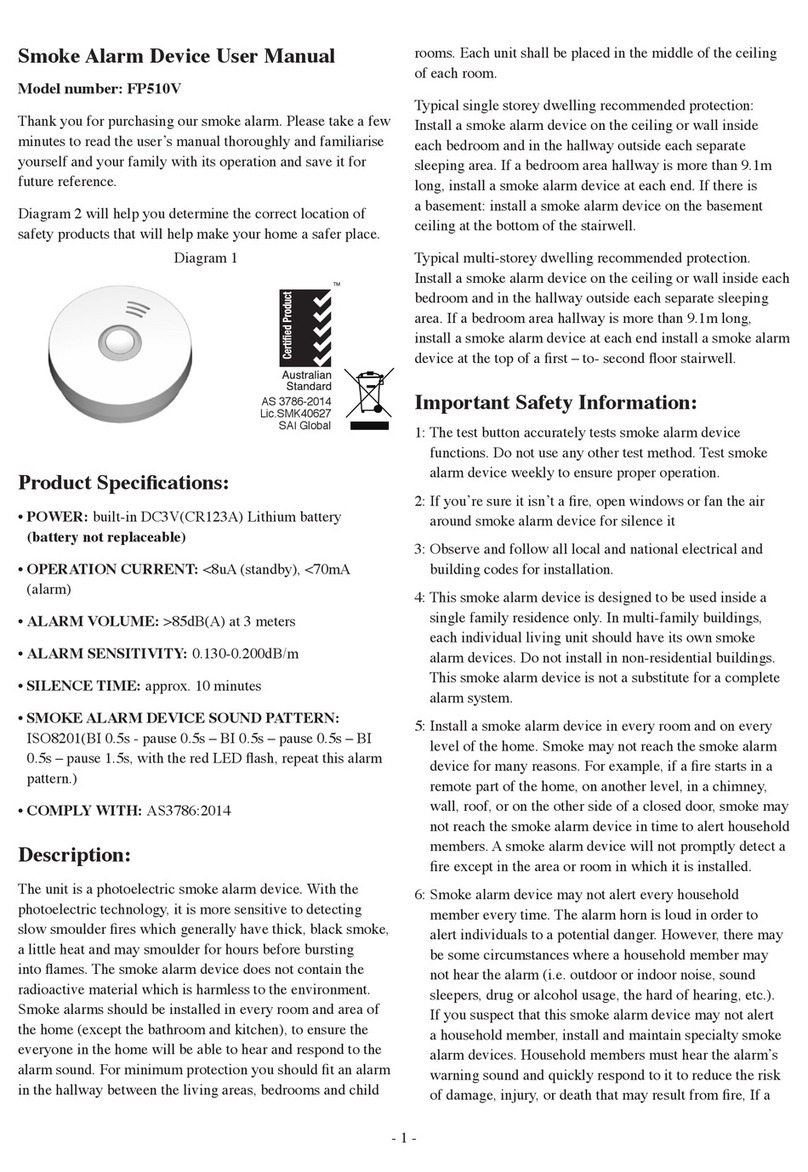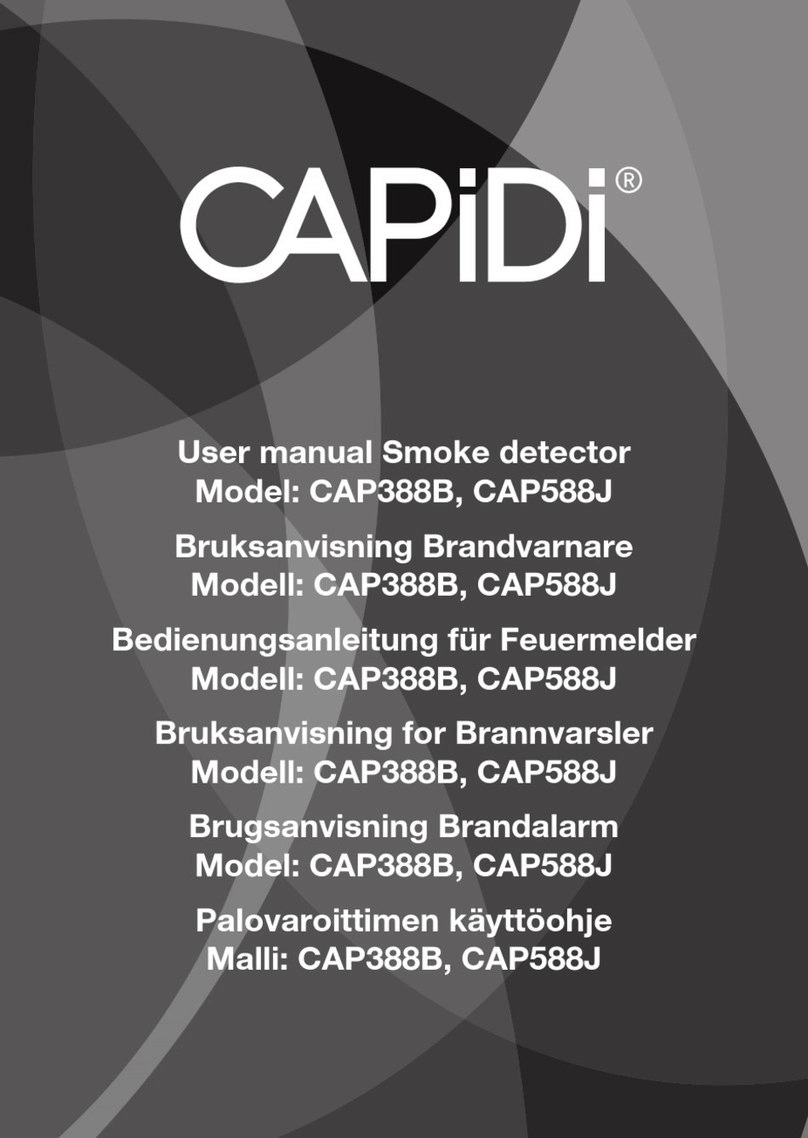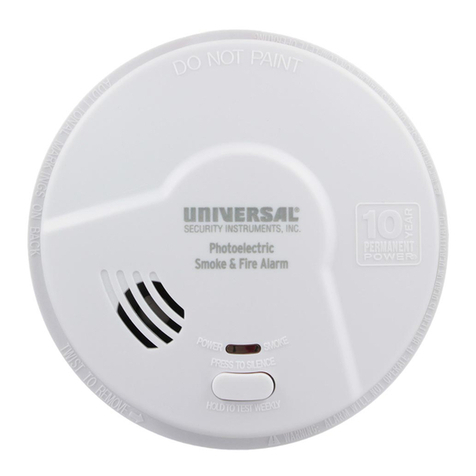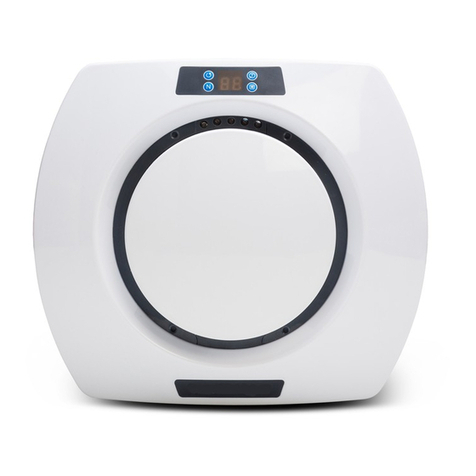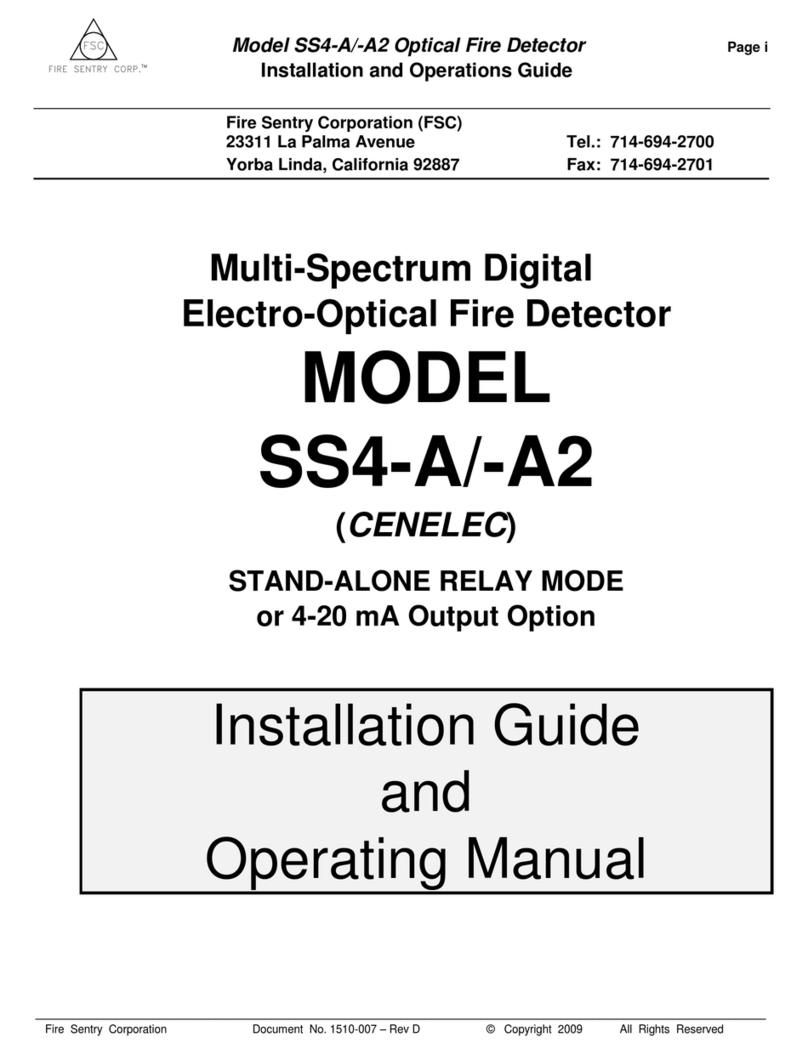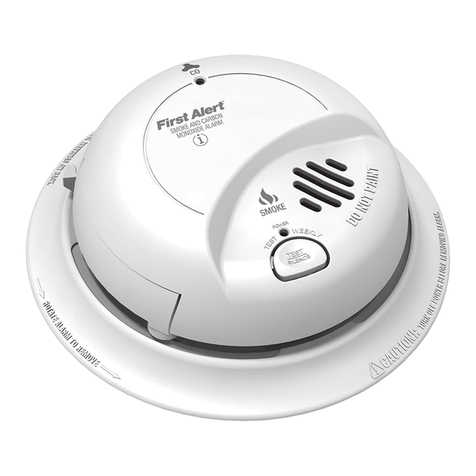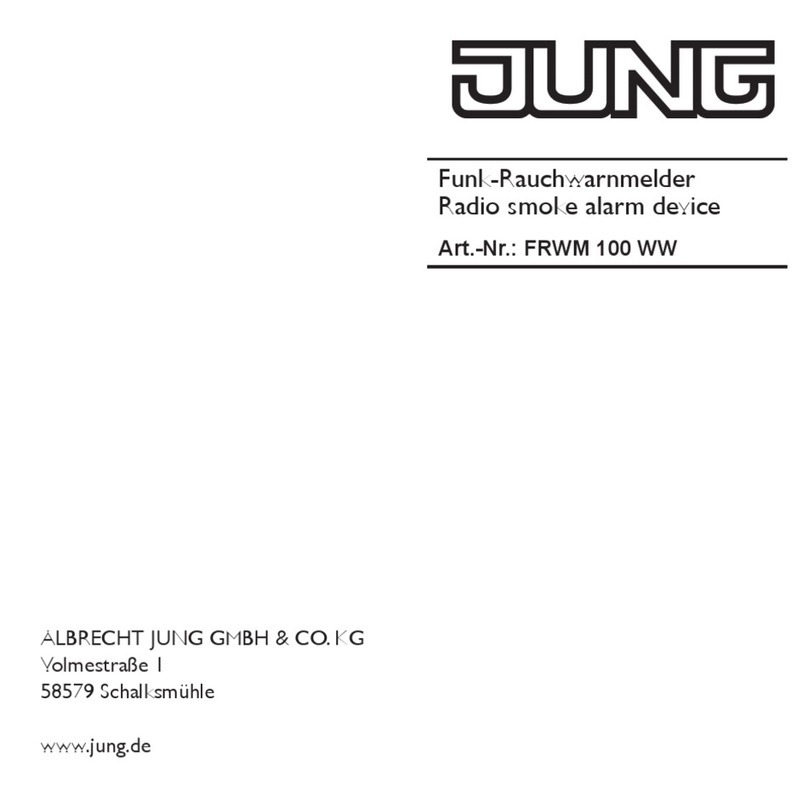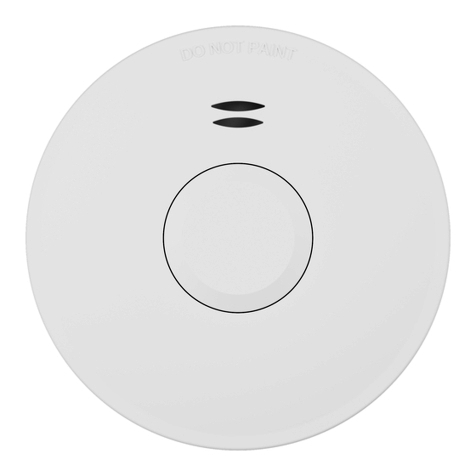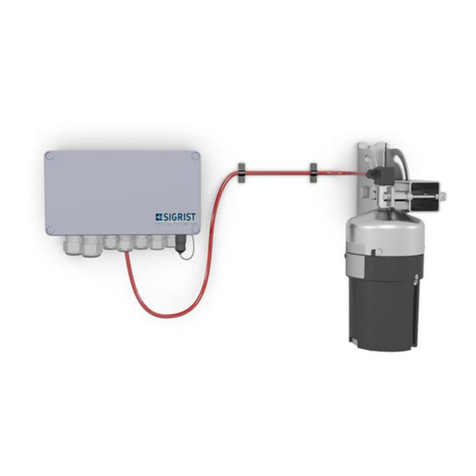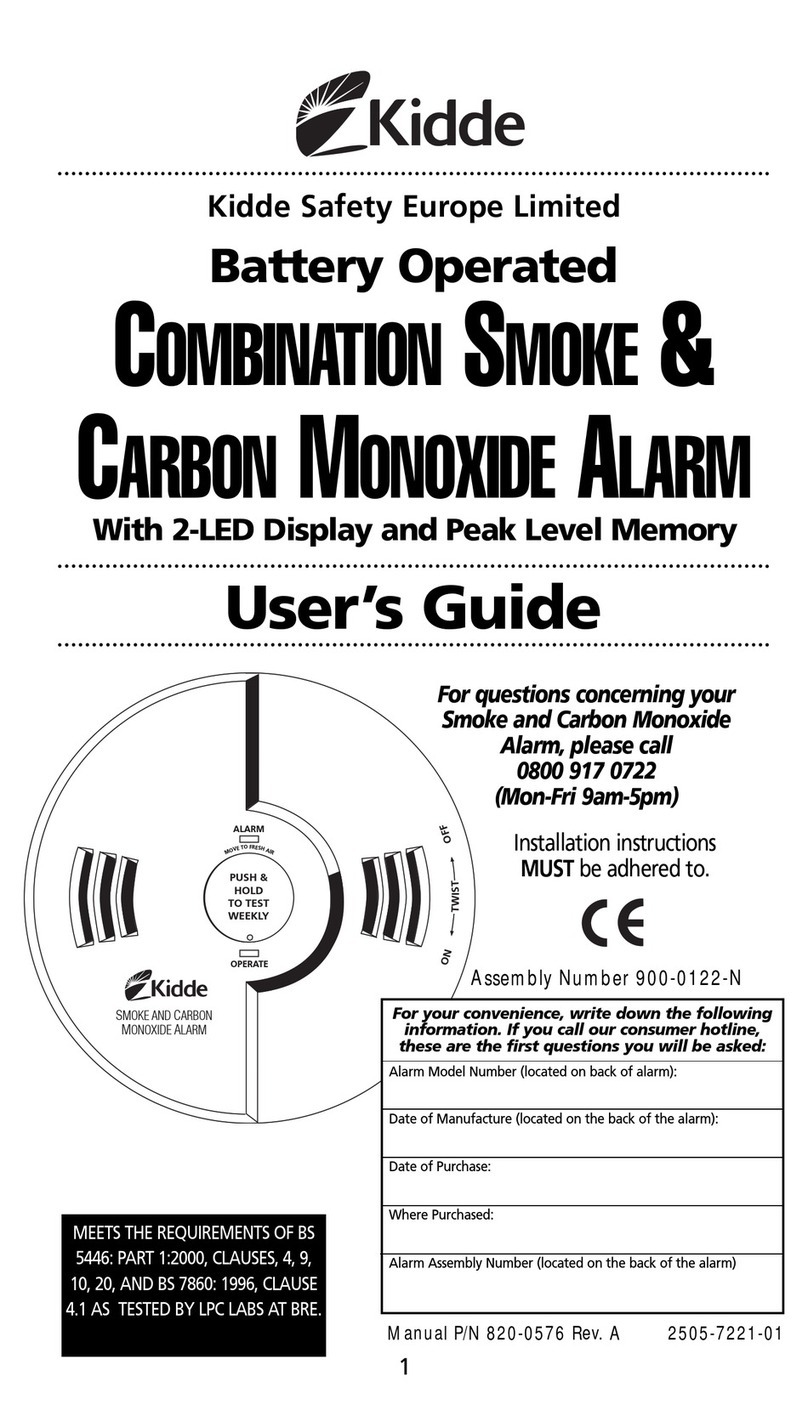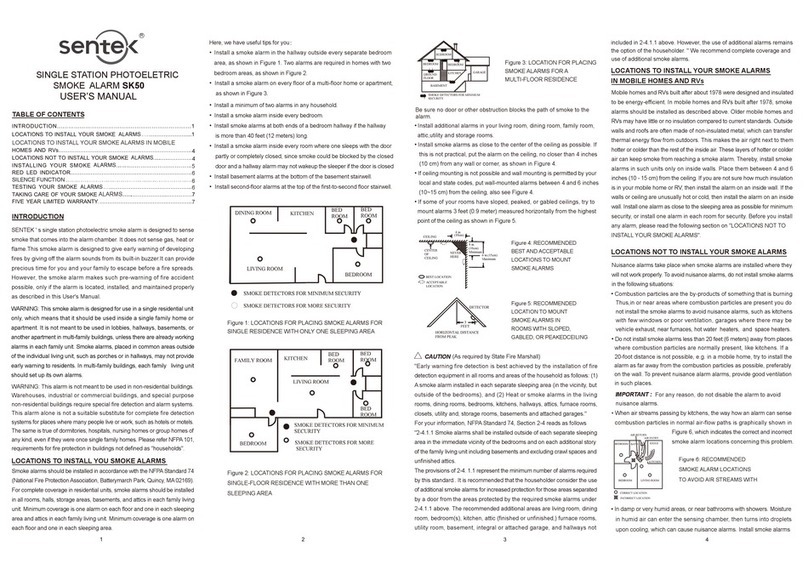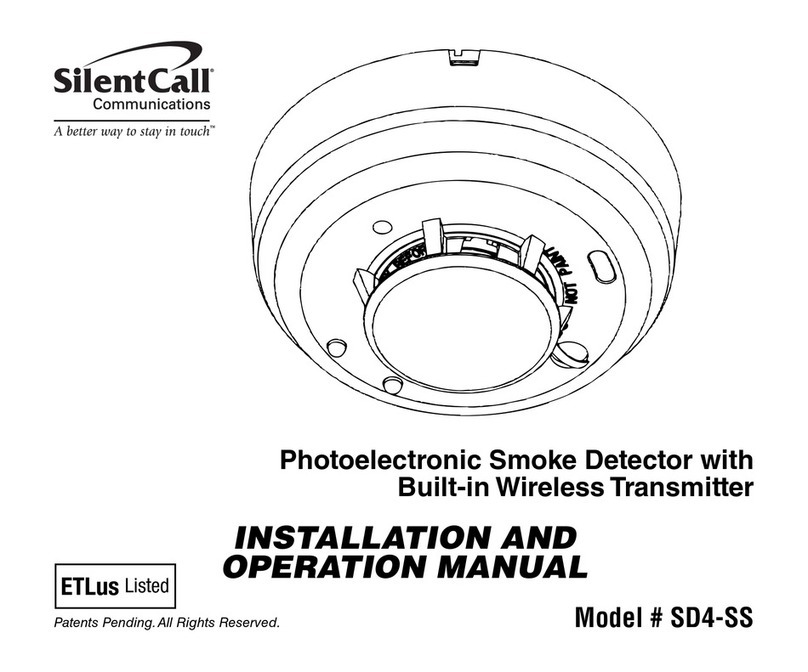Fire Pro FP240V User manual

Document NO.:RD-517E-39-001 Version: D 2017.04.28
- 1 -
Smoke Alarm User Manual
Model number: FP240V
Thank you for purchasing our smoke alarm. Please take a
few minutes to read the user’s manual thoroughly and
familiarize yourself and your family with its operation. And
save it for future reference.
Product Specifications:
POWER:AC220~240V 50Hz with 9V battery backup.
OPERATION CURRENT:<100mA
ALARM VOLUME: > 85dB(A) at 3 meters.
ALARM SENSITIVITY: 0.127~0.208dB/m
SAME PUSH TEST BUTTON TO ACTIVATE
SILENCE (HUSH) CONTROL
HUSH TIME: approx 8 minutes
INTERCONNECTION: up to 12 detectors
BATTERY LIFE: above one year
COMPLY WITH: AS3786:2014
SOUND PATTERN: ISO8201(BI 0.5s - pause 0.5s - BI
0.5s - pause 0.5s - BI 0.5s - pause 1.5s, with the RED
LED flash, repeat this alarm pattern)
Description:
The unit is a photoelectric AC220~240V with 9V DC battery
backup smoke alarm. With the photoelectric technology, it is
more sensitive to detecting slow smolder fires which general
thick, black smoke, little heat and may smolder for hours
before bursting into flames. The smoke alarm does not
contain the radioactive material which is harmless to the
environment.
The smoke alarm should be installed in every room (except
the bathroom), and every other area of the home, making sure
the people in the home will be able to hear and respond to the
alarm sound. For minimum protection you should fit an
alarm in the hallway between the living areas and sleeping
areas. Place the unit near to the living areas as possible and
ensure the alarm is audible when the bedrooms are occupied.
Typical single storey dwelling with recommended:
Install a smoke alarm on the ceiling inside each bedroom and
in the hallway outside each separate sleeping area. If a
bedroom area hallway is more than 30 feet long, install a
smoke alarm at each end. If there is a basement: install a
smoke alarm on the basement ceiling at the bottom of the
stairwell.
Typical multi-storey dwelling with recommended protection.
Install a smoke alarm on the ceiling inside each bedroom and
in the hallway outside each separate sleeping area. If a
bedroom area hallway is more than 30 feet long, install a
smoke alarm at each end install a smoke alarm at the top of a
first – to- second floor stairwell.
Important Safety Information:
1. The test button accurately tests smoke alarm functions. Do
not use any other test method. Test smoke alarm weekly to
ensure proper operation.
2. When the smoke alarm is alarming, if you're sure it isn't a
really alarm, open windows or fan the air around smoke
alarm for silence it.
3. The apparatus shall not be exposed to dripping or
splashing and that no objects filled with liquids, such as
vases, shall be placed on the apparatus.
4. A non-pure sinusoidal power sources is not suitable for
this smoke alarm (e.g. derived from square-wave
invertors).
5. This smoke alarm is powered by AC 220~240V. This
source power is danger to human body. The smoke alarm
should be installed only by a licensed, qualified electrician.
Observe and follow all local and national electrical and
building codes for installation.
6. This smoke alarm is designed to be used inside a single
family only. In multifamily buildings, each individual
living unit should have its own smoke alarms. Do not
install in non-residential buildings. And this smoke alarm
is not a substitute for a complete alarm system.
7. Install a smoke alarm in every room and on every level of
the home. Smoke may not reach the smoke alarm for many
reasons. For example, if a fire starts in a remote part of the
home, on another level, in a chimney, wall, roof, or on the
other side of a closed door, smoke may not reach the
smoke alarm in time to alert household members. A smoke
alarm will not promptly detect a fire except in the area or
room in which it is installed.
8. Smoke alarm may not alert every household member
every time. The alarm horn is loud in order to alert
individuals to a potential danger. However, there may be

Document NO.:RD-517E-39-001 Version: D 2017.04.28
- 2 -
some circumstances where a household member may not
hear the alarm (i.e. outdoor or indoor noise, sound sleepers,
drug or alcohol usage, the hard of hearing, etc.). If you
suspect that this smoke alarm may not alert a household
member, install and maintain specialty smoke alarms.
Household member must hear the alarm’s warning sound
and quickly respond to it to reduce the risk of damage,
injury, or death that may result from fire, If a household
member is hard of hearing, install special smoke alarms
with lights or vibrating devices to alert occupants.
9. Smoke alarms can only sound their alarms when they
detect smoke or detect combustion particles in the air.
They do not sense heat, flame, or gas. This smoke alarm is
designed to give audible warning of a developing fire.
However, many fires are fast - burning, explosive, or
intentional, and others are caused by carelessness or safety
hazards. In this circs, Smoke may not remake the unit
alarm QUICKLY ENOUGH to ensure safe escape.
10. Smoke alarms have limitations. This smoke alarm is not
foolproof and is not warranted to protect lives or property
from fire. Smoke alarms are not a substitute for insurance.
Homeowners and renters should insure their lives and
property. In addition, it is possible for the smoke alarm to
fail at any time. For this reason, you must test the smoke
alarm weekly and replace unit after 10 years.
Battery Specification:
Voltage: DC 9V (Alkaline. Carbon Zinc, Lithium battery)
Gold Peak: GP1604S;(Carbon Zinc Battery)
Gold Peak: GP1604A;(Alkaline Battery)
Raymax : 6LR61; (Alkaline Battery)
EVE: CR9V/P. (Lithium battery)
Replace Battery:
1: Replace the battery:
1Remove the locking plug between bracket and bottom
cover. (See Diagram 1)
Diagram 1
2Remove the alarm body from the bracket.
3Squeeze the locking arms on the sides of the AC Quick
connector while pulling the connector away from the
bottom of the alarm.
4After alarm has been removed, you can open the battery
cover and replace with new battery. (See Diagram 2)
Diagram 2
Warning: AC power should be turned off at this stage.
2: After you replaced the battery:
1Close the battery cover,
2then plug the AC QUICK CONNECTOR into the back
of the alarm, making sure that the locks on the connector
snap into place.
3Fit the alarm body on bracket and turn the alarm body
clockwise (See Diagram 3).
Diagram 3
4Insert locking plug into the gap between bracket and
bottom cover (See Diagram 4).
Diagram 4
3: Turn on the AC power, in the meantime, the green LED
lights up. Then test smoke alarm using test button, the
sound pattern is 3 short beeps-pause 1.5 seconds, cycle
this pattern till release the test button.
Then unit will goes into hush mode of 8 minutes. During this
period, the RED LED will flash once every 8 seconds. It will
go to normal work status and flash once every 32 seconds
after 8 minutes. When you push the test button, if there’s no
sound output, it means that the smoke alarm is faulty or the
installing operation is wrong, and you can get helps from the
section: “trouble shooting”.
CAUTION: Test the smoke alarm for correct operation
using the test facility whenever the battery is replaced.
WARNING: The AC power is danger. When you replace
battery, you must make sure the AC power is turned off.
Do Not Install Smoke Alarms in the
Following Places:

Document NO.:RD-517E-39-001 Version: D 2017.04.28
- 3 -
1.In the garage. Products of combustion are present when
you start your automobile.
2.Less than20" (50cm) from the peak of an “A” frame type
ceiling. (See Diagram 4)
3.In an area where the temperature may fall below 0℃or rise
above 40℃, such as garages and unfinished attics.
4.In dusty areas. Dust particles may cause nuisance alarm or
failure to alarm.
5.In very humid areas (greater than 93% R.H.). Moisture or
steam can cause nuisance alarms.
6.In insect-infested areas.
7.Smoke alarms should not be installed within 3 ft (0.9m) of
the following: the door to a kitchen, the door to a bathroom
containing a tub or shower, forced air supply ducts used for
heating or cooling, ceiling or whole house ventilating fans,
or other high air flow areas.
8.Kitchens. Normal cooking may cause nuisance alarms. If a
kitchen alarm is desired, it should have an alarm silence
feature or be a photoelectric type.
9.Near fluorescent lights. Electronic “noise” may cause
nuisance alarms.
10. Smoke alarms are not to be used with detector guards.
Unless the combination (alarm and guard) has been
evaluated and found suitable for that purpose.
Operation:
Testing:
Test the unit to ensure proper operation by pressing the Test
button for at least 5 seconds, this will sound the alarm if the
electronic circuitry, horn and battery are working properly. If
no alarm sounds, the unit has a defective battery or other
failure. Refer to “Trouble shooting” section for a solution.
DO NOT use an open flame to test your alarm, you could
damage the alarm or ignite combustible materials and start a
fire.
CAUTION: Due to the loudness (85 decibels) of the alarm,
always stand an arms-length always from the unit when
testing.
Test the alarm weekly to ensure proper operation. Erratic or
low sound coming from your alarm may indicate a defective
alarm
NOTE: WEEKLY TESTING IS REQUIRED.
LED indicators:
Illumination of the Green LED indicates that the alarm is
receiving AC power.
This alarm is equipped with a red LED indicator, with two
modes of operation.
Red LED-Flashing every 32 seconds: indicates that the
smoke alarm is operating properly.
RED LED-Flashing: when the Test button is pressed or the
smoke alarm sense particles of combustion and goes into
alarm (constant pulsating sound), the red LED will flash once
per second. The flashing LED and pulsating alarm will
continue until the test button is released or the air is cleared.
RED LED-Alarm silencer (Hush mode) indication: The red
LED will flash every 8 seconds, indicating the smoke alarm
is in the alarm silencer (Hush) mode.
NOTE: WEEKLY TESTING IS REQUIERED.
Alarm silence (hush mode):
When you push same Test button for at least 5 seconds (or
until the unit sounds) to active silence control, the alarm will
enter to HUSH mode for approx 8 minutes. Smoke alarms
are designed to minimize nuisance alarms. Combustion
particles from cooking may set off the alarm if the alarm is
located close to the cooking area. Large quantities of
combustible particles are generated from spills or when
grilling/frying. Using the fan on a range hood that vents to
outside (non-recirculation type) will also help remove these
combustible particles from the kitchen. The alarm silence
(test button) is extremely useful in a kitchen area or other
areas prone to nuisance alarms.
The alarm silence (hush mode) has the capability of
temporarily forbid the alarm circuit to detect smoke for about
8 minutes. This feature is to be used only when a known
alarm condition, such as smoke from cooking, activates the
alarm.
The smoke alarm will automatically reset after approximately
8 minutes, if after this period, particles of combustion are still
present, the alarm will sound again.
The alarm silencer (hush mode) can be repeatedly until the
air has been cleared of the condition causing the alarm.
CAUTION: Before using the alarm silence (hush), identify
the source of the smoke and be certain a safe condition exists.
DANGER: If the alarm sounds, and it is not being tested, it
means the unit is sensing smoke, THE SOUND OF THE
ALARM REQUIRES YOUR IMMEDIATE ATTENTION AND
ACTION.
Repair:
Caution: Do not attempt to repair the alarm. It will affect
your warranty.
If the alarm is not operating properly, and is still under
warranty, return it to the original place you buy. Pack it in a
well-padded carton, and ship to the original place you buy.

Document NO.:RD-517E-39-001 Version: D 2017.04.28
- 4 -
If the alarm is no longer under warranty, replace it
immediately with a comparable alarm.
Trouble shooting:
Problem
Cause and Remedy
The green LED does
not light when AC
power supply.
1.Check the AC QUICK
CONNECTOR is properly connect
to the smoke alarm.
2.If the problem still exists, please
return to your retailer.
3.If the unit is out of warranty,
please replace another new alarm.
Smoke alarm does not
sound when tested.
NOTE: Push test
button for at least five
seconds while testing!
1.Ensure that the battery and
the AC QUICK CONNECTOR is
properly connected.
2. Clean smoke alarm.
3. If there are still failures during
warranty, you can return to your
retailer.
4. If the unit is out of warranty ,
please replace another new alarm
The alarm chirp
occurs every about
approx 32 seconds,at
the same time as the
red LED flash once
The battery is in low battery status,
please replace battery, and refer to
“replace battery” section.
Smoke alarm chirp
occurs every approx
32 seconds (alarm
goes into fault mode).
1.Clean smoke alarm. Please refer to
the “maintenance and cleaning”
section.
2.Purchase and change another
smoke alarm if the problem still
exist
Smoke alarm sounds
unwanted alarms
intermittently or
when residents are
cooking, taking
showers, etc.
1.Press test button to pause alarm.
2. Clean smoke alarm device. Please
refer to the “maintenance and
cleaning” section.
3. Move smoke alarm device to new
location and press test button..
The alarm sounds
different from it is
used to. It starts and
stops.
1.Clean smoke alarm device. Please
refer to the “maintenance and
cleaning” section.
2.If there are still failures during
warranty, you can return to your
retailer.
3. if the unit is out of warranty ,
please replace another new alarm.
WARNING: Do not disconnect battery to quiet an unwanted
alarm. This will remove your protection. Fan the air or open a
window to remove smoke or dust.
Maintenance and Cleaning:
In addition to weekly testing, cleaning to remove dust, dirt,
and debris at least once a month. Always turn off the power
before cleaning.
Use a vacuum cleaner with the soft brush, vacuum all sides
and covers of smoke alarm. Be sure all the vents are free of
debris. Use a damp cloth to clean the alarm’s cover.
This smoke alarm uses a 9 volt battery. A fresh battery should
last for at least one year under normal operate conditions.
This alarm has a low battery monitor which will cause the
alarm to “chirp” and at the same time as the red LED flash
approx every 32 seconds for a minimum of thirty days when
the battery gets low. Replace the battery when this condition
occurs. Please refer to “REPLACE BATTERY”.
IMPORTANT: Do not attempt to remove the cover to clean
inside. This will affect warranty.
Develop and Practice a Plan of Escape:
• Install and maintain fire extinguishers on every level of the
home and in the basement and garage. Know how to use a
fire extinguisher prior to an emergency.
• Make a floor plan indicating all doors and windows and at
least two escape routes from each room. Second story
windows may need a rope or chain ladder.
• Have a family meeting and discuss your escape plan,
showing everyone what to do in case of fire.
• Determine a place outside your home where you all can
meet if a fire occurs.
• Familiarize everyone with the sound of the smoke alarm
and train them to leave your home when they hear it.
• Teach all household members to touch the door and use an
alternate exit when the door is hot, instruct them not to
open the door if the door is hot.
• Teach household members to crawl along the floor to stay
below dangerous smoke, fumes and gases.
• Practice a fire drill at least every six months, including fire
drills at night. Ensure that small children hear the alarm
and wake when it sounds. They must wake up in order to
execute the escape plan. Practice allows all occupants to
test your plan before an emergency. You may not be able to
reach your children. It is important they know what to do.
• Current studies have shown smoke alarms may not awaken
all sleeping individuals, and that it is the responsibility of
individuals in the household that are capable of assisting
others to provide assistance to those who may not be
awakened by the alarm sound, or to those who may be

Document NO.:RD-517E-39-001 Version: D 2017.04.28
- 5 -
incapable of safely evacuating the area unassisted.
What to do when the alarm sounds:
1. Alert small children in the home to quickly follow the
family escape plan.
2. Leave immediately by your escape plan. Every second
counts, so don’t waste time getting dressed or picking up
valuables.
3. In leaving, don’t open any inside door without first feeling
its surface. If hot, or if you see smoke seeping through
cracks, don’t open that door! Instead, use your alternate
exit. If the inside of the door is cool, place your shoulder
against it, open it slightly and be ready to slam it shut if
heat and smoke rush in.
4. Stay close to the floor if the air is smoky. Breathe
shallowly through a cloth, wet if possible.
5. Once outside, go to your selected meeting place and make
sure everyone is there.
6. Call the fire department from your neighbor’s home -not
from yours!
7. Don’t return to your home until the fire officials say that it
is all right to do so.
Note: These guidelines will assist you in the event of a fire,
however, to reduce the chance that fires will start, practice
fire safety rules and prevent hazardous situations.
Recommended Locations for Alarms:
Locate the first alarm in the immediate area of the
bedrooms. Try to monitor the exit path as the bedrooms are
usually farthest from the exit. If more than one sleeping
area exists, locate additional alarms in each sleeping area.
Locate additional alarms to monitor any stairway as
stairways act like chimneys for smoke and heat.
Locate at least one alarm on every floor level.
Locate an alarm in every bedroom.
Locate an alarm in every room where electrical appliances
are operated (i.e. portable heaters or humidifiers).
Locate an alarm in every room where someone sleeps with
the door closed. The closed door may prevent an alarm not
located in that room from waking the sleeper.
Smoke, heat, and combustion products rise to the ceiling
and spread horizontally. Mounting the smoke alarm on the
ceiling in the center of the room places it closest to all
points in the room. Ceiling mounting is preferred in
ordinary residential construction.
When mounting an alarm on the ceiling, locate it at a
minimum of 12" (30cm) from the side wall (Refer to
Diagram 5).
Diagram 5
Put smoke alarm at both ends of a bedroom hallway or
large room if the hallway or room is more than 9.1 m (30 ft)
long.
Smoke alarms in rooms with ceiling slopes greater than 1m
in 8 m horizontally shall be located on the high side of the
room. Install a smoke alarms on sloped, peaked or cathedral
ceilings between 500mm and 1500mm from the highest
point of the ceiling. (See Diagram 6).
Diagram 6
• For single floor plan and multiple floor plan, please refer to
diagram 7.

Document NO.:RD-517E-39-001 Version: D 2017.04.28
- 6 -
Diagram 7
Wiring Instructions:
The appropriate power source is 220~240 volt AC single
phase supplied. When install or remove the smoke alarm,
you must turn off the AC power to ensure safety.
Connecting wires are recommended to use a cross
sectional area from 0.8 mm2to 1.5 mm2, or according to
local wiring standard.
The smoke alarm device shall be provided with an
ALL-POLE MAINS SWITCH from a circuit within the
household consumer unit. The ALL-POLE MAINS
SWITCH shall have a contact separation of at least 3 mm
in each pole.
Should use the terminal to connect the AC QUICK
CONNECTOR and AC main power supply. The terminal
should allow the connection of conductors having
nominal cross-sectional areas of between 0.4mm2and 1.5
mm2. (refer to Diagram 9)
When alarms are interconnected, all interconnected units
must be powered from a single circuit.
A maximum of 12 Siterwell devices recommended may be
interconnected in a multiple station arrangement, over 12
devices maybe result in overload.
Diagram 8 illustrates interconnection wiring, inapposite
connection may result in damage to the alarm, failure to
operate, or a shock hazard.
Wire on alarm harness connected to:
Brown wire --- Live wire of AC line
Blue wire --- Neutral wire of AC line
White wire --- I/O signal as interconnect line of other
Units in the multiple station set up.
Mounting Instructions:
After selecting the proper location for your smoke alarm,
wiring the AC QUICK CONNECTOR harness as
described in the Wiring instructions (AC power should be
turned off at this stage).
Turn the alarm body counterclockwise and take off the
bracket.
Remove locking plug from the bracket with screwdriver
(refer to Diagram 9).
Hold the bracket on the installation position, mark
installation hole of the bracket with pencil.
Bore two installation holes on the sign with electric drill.
Make diameter of holes is 5mm, Strike the two plastic
plugs into holes with hammer.
Pull the AC QUICK CONNECTOR through the center
hole in the bracket. Attach the bracket to the plastic plugs
and fix tightly the screws into the plastic plugs. (Refer to
Diagram 10 - installation sketch map).
Fix the battery into battery box.
Connect the AC QUICK CONNECTOR to the alarm
body.
Fit the alarm on the bracket and turn the alarm body
clockwise, until matching well on the bracket.
Insert locking plug into the gap between bracket and
bottom cover for locking alarm in place (Refer to
Diagram 11).
Diagram 11
Live wire
Neutral wire
Signal wire
white
blue
brown
First
alarm
Additional
alarm
Additional
alarm
locking plug
Diagram 9
Diagram 8

Document NO.:RD-517E-39-001 Version: D 2017.04.28
- 7 -
Turn on the AC power. The green LED should be lit when
the alarm is operating from AC power.
Test smoke alarm using test button. The alarm will sound
3 short beeps – 1.5 seconds pause. Then repeat it until
release the button.
To prevent injury, this unit must be securely attached to
ceiling in accordance with the installation instructions.
Service and Warranty:
Company warrants to the original consumer. Purchase each
new smoke alarm to be free from defects in material and
workmanship under normal use and service for a period of
If after reviewing this manual you feel that your smoke alarm
is defective in any way, do not tamper with the unit. Return it
for servicing to:
FirePro
138–140 Bayfield Rd East,
Bayswater North, VIC, 3153. Australia.
P (03) 9720 4333 F (03) 9720 4344
MODEL NUMBER: FP240V
Installation sketch map:
Diagram 10
Terminal
10
years (exclude battery)from the date of purchase. This
warranty does not cover damage resulting from accident,
misuse or abuse or lack of reasonable care of the product. In no
case shall company be liable for any incidental or consequential
damages for breach of this or any other warranty express or
implied, whatsoever. The bad product can be mailed to the
following address with a detail explanation of problem.
Table of contents
Other Fire Pro Smoke Alarm manuals


